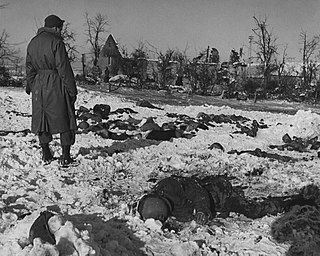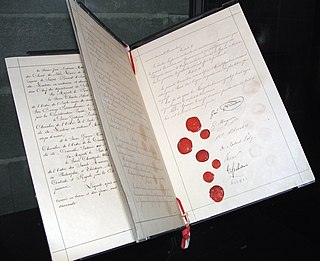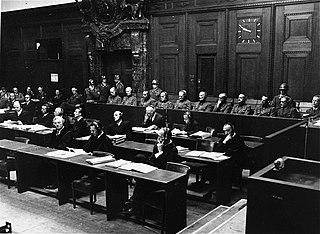
A war crime is a violation of the laws of war that gives rise to individual criminal responsibility for actions by combatants in action, such as intentionally killing civilians or intentionally killing prisoners of war, torture, taking hostages, unnecessarily destroying civilian property, deception by perfidy, wartime sexual violence, pillaging, and for any individual that is part of the command structure who orders any attempt to committing mass killings including genocide or ethnic cleansing, the granting of no quarter despite surrender, the conscription of children in the military and flouting the legal distinctions of proportionality and military necessity.

The law of war is the component of international law that regulates the conditions for initiating war and the conduct of hostilities. Laws of war define sovereignty and nationhood, states and territories, occupation, and other critical terms of law.
National treatment is a principle in international law. Utilized in many treaty regimes involving trade and intellectual property, it requires equal treatment of foreigners and locals. Under national treatment, a state that grants particular rights, benefits or privileges to its own citizens must also grant those advantages to the citizens of other states while they are in that country. In the context of international agreements, a state must provide equal treatment to citizens of the other states participating in the agreement. Imported and locally produced goods should be treated equally — at least after the foreign goods have entered the market.

The Nuremberg principles are a set of guidelines for determining what constitutes a war crime. The document was created by the International Law Commission of the United Nations to codify the legal principles underlying the Nuremberg Trials of Nazi party members following World War II.

The First Geneva Convention for the Amelioration of the Condition of the Wounded in Armies in the Field, held on 22 August 1864, is the first of four treaties of the Geneva Conventions. It defines "the basis on which rest the rules of international law for the protection of the victims of armed conflicts."
Cruel and unusual punishment is a phrase in common law describing punishment that is considered unacceptable due to the suffering, pain, or humiliation it inflicts on the person subjected to the sanction. The precise definition varies by jurisdiction, but typically includes punishments that are arbitrary, unnecessary, or overly severe compared to the crime.

The Hostages Trial was held from 8 July 1947 until 19 February 1948 and was the seventh of the twelve trials for war crimes that United States authorities held in their occupation zone in Germany in Nuremberg after the end of World War II. These twelve trials were all held before US military courts, not before the International Military Tribunal, but took place in the same rooms at the Palace of Justice. The twelve US trials are collectively known as the "Subsequent Nuremberg Trials" or, more formally, as the "Trials of War Criminals before the Nuremberg Military Tribunals" (NMT).

Protocol II is a 1977 amendment protocol to the Geneva Conventions relating to the protection of victims of non-international armed conflicts. It defines certain international laws that strive to provide better protection for victims of internal armed conflicts that take place within the borders of a single country. The scope of these laws is more limited than those of the rest of the Geneva Conventions out of respect for sovereign rights and duties of national governments.

The Code of the U.S. Fighting Force is a code of conduct that is an ethics guide and a United States Department of Defense directive consisting of six articles to members of the United States Armed Forces, addressing how they should act in combat when they must evade capture, resist while a prisoner or escape from the enemy. It is considered an important part of U.S. military doctrine and tradition, but is not formal military law in the manner of the Uniform Code of Military Justice or public international law, such as the Geneva Conventions.

Juan E. Méndez is an Argentine lawyer, former United Nations Special Rapporteur on Torture and Other Cruel, Inhuman or Degrading Treatment or Punishment, and a human rights activist known for his work on behalf of political prisoners.
Security of the person is a basic entitlement guaranteed by the Universal Declaration of Human Rights, adopted by the United Nations in 1948. It is also a human right explicitly defined and guaranteed by the European Convention on Human Rights, the Constitution of Canada, the Constitution of South Africa and other laws around the world.
The United Nations Standard Minimum Rules for the Administration of Juvenile Justice, often referred to as the Beijing Rules, is a resolution of the United Nations General Assembly regarding the treatment of juvenile prisoners and offenders in member nations.

The United Nations Standard Minimum Rules for the Treatment of Prisoners were adopted by the United Nations General Assembly on 17 December 2015 after a five-year revision process. They are known as the Mandela Rules in honor of the former South African President, Nelson Mandela. The Mandela Rules are composed of 122 "rules". Not all are rules, but some are principles such as institutional equality and the philosophy of confinement.
In United States law, habeas corpus is a recourse challenging the reasons or conditions of a person's detention under color of law. The Guantanamo Bay detention camp is a United States military prison located within Guantanamo Bay Naval Base. A persistent standard of indefinite detention without trial and incidents of torture led the operations of the Guantanamo Bay detention camp to be challenged internationally as an affront to international human rights, and challenged domestically as a violation of the Due Process Clause of the Fifth and Fourteenth amendments of the United States Constitution, including the right of petition for habeas corpus. On 19 February 2002, Guantanamo detainees petitioned in federal court for a writ of habeas corpus to review the legality of their detention.

The Yogyakarta Principles is a document about human rights in the areas of sexual orientation and gender identity that was published as the outcome of an international meeting of human rights groups in Yogyakarta, Indonesia, in November 2006. The principles were supplemented and expanded in 2017 to include new grounds of gender expression and sex characteristics and a number of new principles. However, the Principles have never been accepted by the United Nations (UN) and the attempt to make gender identity and sexual orientation new categories of non-discrimination has been repeatedly rejected by the General Assembly, the UN Human Rights Council and other UN bodies.

The Geneva Conventions are international humanitarian laws consisting of four treaties and three additional protocols that establish international legal standards for humanitarian treatment in war. The singular term Geneva Convention colloquially denotes the agreements of 1949, negotiated in the aftermath of the Second World War (1939–1945), which updated the terms of the two 1929 treaties and added two new conventions. The Geneva Conventions extensively define the basic rights of wartime prisoners, civilians and military personnel; establish protections for the wounded and sick; and provide protections for the civilians in and around a war-zone.
The UN Principles of Medical Ethics is a code of medical ethics relating to the "roles of health personnel in the protection of persons against torture and other cruel, inhuman or degrading treatment or punishment.", adopted by the United Nations on 18 December 1982 at the 111th plenary meeting of the United Nations General Assembly.
The European Prison Rules were drawn up by the Council of Europe. They are intended to provide legally non-binding standards on good principles and practices in the treatment of detainees and the management of detention facilities. They were most recently revised in 2020.

The United Nations Congress on Crime Prevention and Criminal Justice is a United Nations (UN) sponsored congress on the topics of crime, crime prevention and criminal justice, held every five years. It is organized by the United Nations Office on Drugs and Crime (UNODC). Participants of the Congress include UN Member States and Observers, international organizations, non-governmental organization and individual experts.

The Commission on Crime Prevention and Criminal Justice (CCPCJ) is a functional commission of the United Nations Economic and Social Council (ECOSOC) based in Vienna. The commission serves as the primary organ that guides the activities of the United Nations in the fields of crime prevention and criminal justice.









